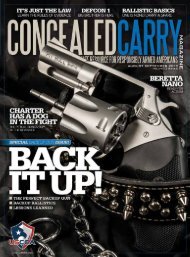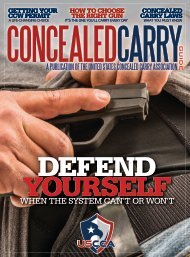Download This Issue - US Concealed Carry
Download This Issue - US Concealed Carry
Download This Issue - US Concealed Carry
Create successful ePaper yourself
Turn your PDF publications into a flip-book with our unique Google optimized e-Paper software.
THE WARRIOR EXPERT<br />
<strong>This</strong> pistol is probably really good at something... but having it as a concealed carry<br />
option would be like driving a Monster Truck at the Indy 500.... tools should fit the<br />
job. Not all guns are created equal and you should choose one that makes your task<br />
easier, not harder!<br />
actual game. When you are defending<br />
yourself, you are doing so from an attack<br />
that ultimately is an ambush in some<br />
form. If it weren’t, then hopefully you<br />
would have avoided it. Even our special<br />
operations military personnel have<br />
trained with us for many years almost<br />
exclusively in Counter Ambush skills<br />
as part of our Extreme Close Quarters<br />
program. In that program, we start with<br />
the premise that the normal CQB procedures<br />
have failed and a bad guy shows<br />
up from an uncovered danger area or<br />
gets in close enough to grab a long gun.<br />
In our S.W.A.T. Training, we assume the<br />
bad guy is not a lethal threat, but does<br />
need to be fought and controlled. In our<br />
Executive Protection training, Personal<br />
Defense programs, Firearms Skill<br />
Development courses, Officer Survival,<br />
Home Defense, <strong>Concealed</strong> <strong>Carry</strong> and<br />
Women’s Assault Prevention programs<br />
all assume that you have been caught<br />
off guard in some way and need to process<br />
information prior to executing any<br />
learned skill.<br />
I often say that my instructors and I<br />
don’t just do firearms training, we strive<br />
to help our students learn how to make<br />
rapid decisions and execute complex<br />
motor skills under extreme and unexpected<br />
stress. <strong>This</strong> enters into all facets<br />
of our programs. How do we do this?<br />
How do we get our students to process<br />
information prior to executing the skills<br />
they’re developing? It can be as easy as<br />
alternating between two commands on<br />
the firing line which indicate engaging<br />
two different types of targets for someone<br />
who just bought their first gun, or<br />
as complex as having multiple, well-rehearsed<br />
and capable role-players engaging<br />
in at-speed close quarters attacks using<br />
impact reduction suits and sim guns<br />
with our country’s greatest warriors. We<br />
even have an App for it, for when you are<br />
training by yourself!<br />
You can integrate this aspect of training<br />
to your own regimen very simply by<br />
forcing yourself to truly perform skills<br />
on demand. Working with a partner, the<br />
next time you are at a range, give each<br />
other short instructions rapidly and execute<br />
the shooting necessary as quickly as<br />
you can. Don’t contemplate the course<br />
of fire and don’t form a strategy ahead<br />
of time. Take the skills you have developed<br />
previously and apply them to the<br />
problem that is presented. <strong>This</strong> starts to<br />
simulate the ambush moment. Having<br />
MAY/JUNE 2011 n CONCEALED CARRY MAGAZINE n <strong>US</strong>CONCEALEDCARRY.COM<br />
complex targets that offer various levels<br />
of deviation control (sizes of targets), set<br />
at different distances and of different<br />
colors and shapes will make the training<br />
easy. “Shoot the red circle once and<br />
bad guy #3 in the chest multiple times,<br />
GO!” that simple sentence can throw the<br />
average “good” shooter’s ability to apply<br />
their skill rapidly into the gutter. Simply<br />
giving the same two instructions, letting<br />
the shooter think about them, asking<br />
them if they are “ready” and then giving<br />
them a signal to execute ruins the whole<br />
thing and makes your shooting a sport,<br />
not Counter Ambush Training. To keep<br />
your defensive shooting training as real<br />
as possible, focus on high center chest<br />
sized targets the majority of the time, require<br />
rapid multiple shot-strings of fire,<br />
engage targets between 6 and 20 feet<br />
away, integrate a flinch prior to drawing,<br />
perform lateral movement while<br />
searching, reloading, assessing, clearing<br />
malfunctions and doing about anything<br />
other than shooting at a target beyond<br />
two arms reach. Understand that precision<br />
is either yes or no. Shooting a tight<br />
group inside of a large target is just wasting<br />
time, not “better.” Try to perform all<br />
of your gun handling without looking at<br />
your gun. Utilizing these tips will make<br />
it more likely that you are really training<br />
for defensive shooting and not just<br />
“shooting.”<br />
The next time you go to the range,<br />
think about a technique or consider a<br />
piece of gear, think about the nine questions<br />
above. Think about the skills you<br />
are going to need and the context in<br />
which you are going to need them. It isn’t<br />
easy to apply the discipline necessary<br />
to follow the counter ambush training<br />
methodology, but it probably won’t be<br />
easy to survive a true ambush either. H<br />
Rob Pincus owns I.C.E. Training and<br />
teaches firearms classes throughout the<br />
country to students interested in learning<br />
more about using firearms in self defense.<br />
The developer of the Combat Focus<br />
shooting program, Pincus also hosts<br />
and writes for Outdoor Channel’s wildly<br />
popular show “The Best Defense” and<br />
“S.W.A.T. Magazine TV.” His work has<br />
appeared in Police, Tactical Response,<br />
SWAT, and GunWorld.<br />
33
















